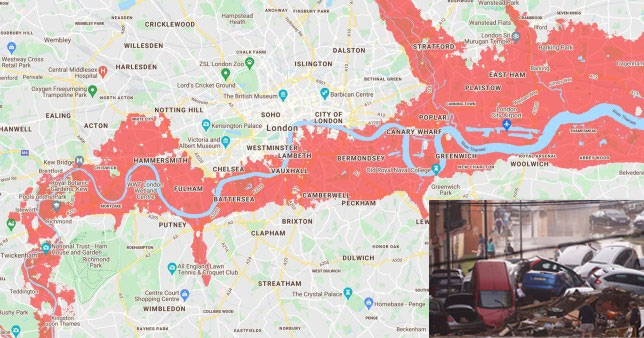If a Valencia Storm Rained on London, what would the impact be?
With Spain tackling its worst flooding disaster in modern history, several countries across Europe will be wondering – could we be next?
Scientists have long warned that climate change means extreme weather will become increasingly frequent and urged nations to be prepared.
So, how would London – home to almost nine million people and the economic centre of the UK – cope if a year’s worth of rain fell in a few hours, as it did in Valencia?
Although it’s difficult to know exactly how it would be impacted, experts have previously said the capital is far from ready for that kind of deluge and could suffer catastrophic consequences.
In January, for example, an independent climate research study, commissioned by London Mayor Sadiq Khan, deemed London seriously underprepared for severe flooding, as well as extreme heat.
And in 2021, the non-profit organisation Climate Central shared a worrying map showing which areas of London are particularly vulnerable to flooding and could be regularly underwater by 2030.

Areas of London expected to be regularly flooded by 2030 (Picture: Climate Central/Getty). Inset Valencia after the storm
The map allows users to explore coastal flood risk and sea level rise projections by decade for anywhere in the world.
Red is used to show areas that will likely be below water level by 2030 and don’t appear to be protected by dikes.
For Londoners, the picture looks bleak.
In West London, most of east Twickenham, Chiswick, Hammersmith and Fulham are covered in red by 2030 – as well asmuch of Kew’s Royal Botanic Gardens.
Almost all of East London could also find itself prone to flooding and sea-level rises, including Greenwich, Stratford, Rotherithe and East Ham.
Like the east and west, a lot of the land south of the river is low and flat.
Battersea, Deptford, Southwark, Camberwell and Peckham will all be vulnerable to flooding by 2030.
Areas in red in north London include Hackney Marshes and Walthamstow reservoirs around the River Lee.
The data is based on a scenario of moderate cuts to pollution, with even more areas covered in red if pollution goes unchecked.
The London Climate Resilience Review report said the capital’s main climate risks were rising sea levels, surface water flooding, heat, drought and wildfires.
Review chairwoman Emma Howard Boyd said at the time:
‘London has many good plans and programmes to prepare for climate hazards but we need to recognise that Londoners now face lethal risks, and a step change is needed.
‘Last year was the hottest on record and this is causing chaos and disruption all over the world.
‘London is not immune, as shown by the flash floods in 2021 and a 40C heatwave in 2022.
‘It’s time for the UK, led by its cities and regions, to take action and prioritise adaptation.’
In response Mr Khan said his latest budget proposed an additional £3m to ‘accelerate climate adaptation work’.
Source: Metro News









Leave a Reply
Want to join the discussion?Feel free to contribute!